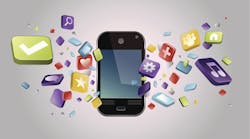Latest from Management
Sponsored
Batteries on typical smartphones last between eight and 10 hours, with 38 percent of smartphone users depleting the battery at least once a week. Late or — even worse — in the middle of a work day, is no time for a smartphone or tablet to run out of juice. Enter the growing category of portable battery chargers.
For example, Jackery Giant +, www.jackery.com, is a streamlined large capacity portable dual USB mobile device charger compatible with a spectrum of iPhone and Galaxy smartphones and tablets. Featuring two charging ports that, together, support up to three amps, it can charge both a smartphone and a tablet simultaneously. The compact Giant + (measuring 4.3” x 3.1” x 0.8”) can greatly extend usability of those devices for the day.
For example, the device, which has 12,000 mAh rechargeable power capacity, can, when fully charged, provide the equivalent battery charge for 2.9 full charge cycles of the iPhone 6s Plus; 4.7 full charge cycles for the iPhone 6s; and 5.1 full charge cycles for the iPhone 5s. For tablets, the charger can provide the equivalent of 0.9 full charge cycles for the iPad Air and 1.6 full charge cycles for the Galaxy Tab S 8.4.
Encased in a brushed aluminum outer shell, the Giant + incorporates an LED flashlight on one end, three LED lights that indicates approximately how much battery charge is left, and automatic shut-off to preserve the battery’s charge. The device comes with a micro USB to USB 2.0 cable.
In addition to uninterrupted battery power, you might also benefit from a portable solution that enhances reception of signal strength from your service provider when working inside buildings or in areas where signal strength is weak. The mJoose 3-in-one smartphone case/battery extender, mjoose.com, is a compact multitasking device that, in addition to granting extra battery power, will amplify signal strength during smartphone use. If the smartphone is used in an area with a 4G or LTE equipped tower in range, it is also designed to improve data connection speeds in weak signal areas by extending the range to other towers, improving Internet connectivity at 4G or LTE speeds. The device works with 2G, 3G, 4G, and LTE for all carriers.
A good signal and a charged battery won’t matter much if you cannot hear the conversation or your hands are not free to pick up your phone. The Jabra STEEL Bluetooth headset, www.jabra.com/steel, is a robust audio solution for hands-free smartphone use in challenging outdoor and indoor listening and working conditions. The headset connects to the mobile phone through either Bluetooth or NFC (near field communication), which is contactless, requiring only waving the headset close to the phone to set it up.
The lightweight headset, which has a hard casing, was put through rigorous testing, including high drops on hard surfaces and exposure to water and other liquid, and is dust, water and shock resistant to U.S. military standards.
Designed to operate in noisy environments, the Jabra STEEL features HD Voice with dual-microphone noise cancellation technology that “listens” to the surrounding environment and isolates the user’s voice. The headset, which has an (phone dependent) operating range of 98 feet and can provide up to up to six hours talk time, affords easy access to Siri/Google Now and allows voice activated call pick-up. With Android phones, it also enables message readout.
You might benefit from a portable solution that enhances reception of signal strength from your service provider.
The device, which comes with three different ear gels for personalized comfort, can be worn on either ear. A “power nap” feature extends standby time. Extra-large buttons enable easy control with gloved or wet hands and two different ear hooks enable a secure fit regardless of the position of the person wearing it — i.e. tilted or even upside down — or if the wearer is exposed to vibrations that jostle the body. A windsock helps ensure clear communications when using the headset outdoors during windy conditions. The headset has a two-hour charging time and comes with a five-year warranty.
Speaking of using smartphones and tablets on the job, COBRA Contractors Software, www.cobra-usa.com, a modular scalable business software suite for small to mid-sized specialty contractors, recently introduced Cobra Mobile Forms, a mobile data capture solution for use with Android phones, iPads and iPhones. It captures job data on the supported devices and wirelessly transmits it directly into COBRA, already installed on the contractor’s main computer in the office. Cobra offers modules for various tasks, including estimating, project management, inventory tracking, service management, billing, job cost, accounting, and payroll.
The mobile forms can be used in two ways. The office can prepopulate each form with customer/job information; customer service history; past installed equipment; tech charge rate; material descriptions with customer pricing/discounts; job tax; and job total calculated for collecting on-site and doing quick quotes and then email the form to each tech prior to start of the workday. When the tech finishes the work, he or she fills out the form and emails it back to the office Cobra software.
Alternately, the tech can populate the form on site, which could be convenient during emergency service calls. COBRA Mobile Forms supports voice-to-text for easy input of job notes onsite and has the capability to capture customer electronic signature and photos directly on the form.
Bill and Patti Feldman write articles and web content for trade magazines and manufacturers of building products. They can be reached at [email protected].


